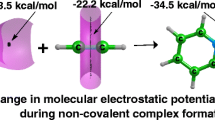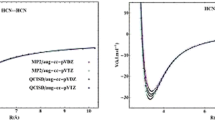Abstract
Within the context of extended geminal models the concepts of charge centroids and charge ellipsoids of the geminal one-electron densities, and an energy decomposition of the intermolecular potential, are introduced as tools of analysis. The intermolecular potential can within this framework be written as a sum of the distortion energies of the subsystems and the interaction energies between the distorted subsystems. The interaction energy is further partitioned into a Coulombic, exchange and correlation contribution. Three classes of complexes are studied: hydrogen bonded systems (HF)2, H2OHF, (H2O)2; strongly bonded electron donor-acceptor (EDA) complexes: BH3NH3, BH3CO; and weakly bonded EDA complexes: F2NH3, Cl2NH3 and ClFNH3. The main results of the calculations, using basis sets consisting of [9s, 6p, 2d](Cl), [7s, 4p, 2d] (B, N, O, F), [4s, 2p](H) contracted Gaussian-type functions, and the numerical models EXRHF3 and EXGEM7, are as follows. The bonding in these complexes is essentially due to a lone pair of the donor subsystems approaching the “vacant” space in the vicinity of a nucleus of the acceptor system. The interaction energy is therefore dominated by the Coulombic term. However, the sum of the distortion terms is larger than the magnitude of the Coulombic term. Hence, the exchange and correlation terms give a substantial contribution to the intermolecular potential. If the components of the decomposition of the potential are resealed by using the magnitude of the interaction energy as the energy unit, a remarkable similarity between the three classes of complexes is disclosed.
Similar content being viewed by others
References
G.C. Maitland, M. Rigby, E.B. Smith and W.A. Wakeham,Intermolecular Forces (Oxford University Press, Oxford, 1981).
P. Hobza and R. Zahradnik, Intermolecular complexes. The role of Van der Waals systems, in:Physical Chemistry and in theBiodisciplines (Elsevier, Amsterdam, 1988).
I. Røeggen, Derivation of an extended geminal model, J. Chem. Phys. 79 (1983)5520.
I. Røeggen, Intermolecular potentials calculated by an extended geminal model: Theory, J. Chem. Phys. 85 (1986)262.
I. Røeggen, and E. Wisløff-Nilssen, Fragment analysis of molecular electronic energies. I. Theory, J. Chem. Phys. 86 (1987)2869.
I. Røeggen, Electron correlation described by extended geminal models: The EXGEM4 and EXGEM5 models, Int. J. Quant. Chem. 31 (1987)951.
I. Røeggen, Electron correlation described by extended gerninal models, J. Chem. Phys. 89 (1988)441.
I. Røeggen, Electron correlation described by extended geminal models: The EXGEM7 and EXRHF3 models, Int. J. Quant. Chem. 37 (1990)585.
I. Røeggen, An analysis of hydrogen-bonded systems: (HF)2, (H2O)2 and H2O · HF, Mol. Phys. 70 (1990)353.
M.A. Robb, W.J. Haines and I.G. Csizmadia, A theoretical definition of the “size” of electron pairs and its stereochemical implications, J. Amer. Chem. Soc. 95 (1973)42.
I.G. Csizmadia, Sizes and shapes of electron pairs, in:Localization and Delocalization in Quantum Chemistry, ed. Chalvet et al. (Reidel, Dordrecht, 1975).
S. Huzinaga and C. Arnau, Gaussian-type functions for polyatomic systems. IV, J. Chem. Phys. 53 (1970)348.
B. Roos and P. Siegbahn, Polarization functions for first and second row atoms in Gaussian-type MO-SCF calculations, Theor. Chim. Acta (Berl.) 17 (1970)199.
L.M.J. Krohn-Batenburg and F.B. van Duijneveldt, The use of a moment-optimized DZP basis set for describing the interaction in the water dimer, J. Mol. Struct. 121 (1985)185.
I. Røeggen, An analysis of electron donor-acceptor complexes: BH3·CO and BH3·NH3, to be submitted to Chem. Phys.
N.H.F. Beebe and J. Linderberg, Simplification in the generation and transformation of two-electron integrals in molecular calculations, Int. J. Quant. Chem. 12 (1977)683.
I. Røeggen, and E. Wisløff-Nilssen, On the Beebe-Linderberg two-electron integral approximation, Chem. Phys. Lett. 132 (1986)154.
J. Breulet and L. Lievin, Comparative theoretical study of the dissociation process of the isoelectronic molecules BH3CO, CH2CO, HNCO, CO2 and BH3N2, CH2N2, HN3, N2O, Theor. Chim. Acta (Berl.) 61 (1982)59.
Author information
Authors and Affiliations
Rights and permissions
About this article
Cite this article
Røeggen, I. An energy decomposition analysis of intermolecular interactions. J Math Chem 10, 205–220 (1992). https://doi.org/10.1007/BF01169175
Issue Date:
DOI: https://doi.org/10.1007/BF01169175




